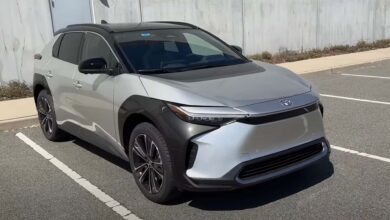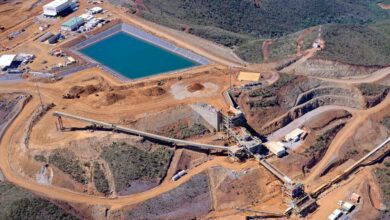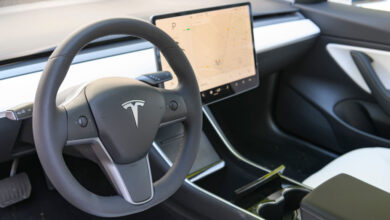Tesla Growth Rate and Production Numbers: Statistics & Facts

Tesla reported its 2024 first-quarter earnings on Tuesday, April 23, with EPS of $0.45, $0.04 worse than the analyst estimate of $0.49. Revenue for the quarter came in at $21.3B versus the consensus estimate of $22.27B.
“It’s a bittersweet report for Tesla bulls as, on the one hand, the EV giant missed financial expectations by a wider margin than initially expected, both on the revenue and the margins front,” said Thomas Monteiro, senior analyst at Investing.com. “However, on the other hand, Elon finally presented investors with a feasible plan to turn things around in the key markets where the company can potentially show the greatest growth. Amid the current price war, particularly in China – and with the prospects of the company venturing into the Indian market – the word “affordable” resonated as music to the ears of shareholders.
“This means the company may just be able to use its gigantic production capacity more efficiently while maintaining the original proposal of its higher-end models. Moreover, it also speaks to the fears that inventory buildups could continue to pressure margins for the year ahead,” he continued. “The announcement also indicates that Elon may be focusing efforts on the EV giant again, which is another piece of good news for shareholders. It’s a promising sign for the company that Elon felt compelled to change its direction amid the myriad of pressures.”
While other automakers delivered their worst sales figures in a decade, Tesla’s delivery statistics were praiseworthy in 2022. The company delivered 1,313,851 vehicles to customers worldwide and, in so doing, increased its deliveries by 40% in comparison to the previous year. It also produced 47% more cars in 2022 compared to 2021.
By selling 491,000 vehicles in America, Tesla won the US luxury sales leader title. It left behind BMW, which had worn this crown for the last three years but sold only 332,388 cars in the United States in 2022 and was thus relegated to second place. With 286,764 cars sold, Mercedez-Benz came third, followed by Lexus, whose sales totaled 258,704 vehicles in 2022. And not only did Tesla outshine these brands, but it also became the first American automaker to top the list in a quarter century.
There is also another point to Tesla’s credit. Because Tesla produces its cars on American soil, in California and Texas, it strengthens American automaking. With Elon Musk, American car manufacturing has made a spectacular comeback.
In 2022, Tesla also expanded its international factories. In March, the first Tesla vehicles were produced in Germany at the newly opened Giga Berlin. Musk’s idea is to turn Giga Berlin into a European crown jewel. The factory in China was also updated to manufacture as many as 750,000 Model 3 and Model Y electric cars annually. During 2022, Tesla installed the capacity, across all of its factories, to produce 100,000 Model S and X vehicles per year, together with 1.8 million Model Y and Model 3 vehicles.
In late 2022, Tesla cut prices on its cars around the world. Model 3 and Model Y vehicles in Australia, France, Germany, the Netherlands, Norway, Switzerland, and the United Kingdom became less expensive. By enabling more people to purchase its cars, Tesla accelerated the world’s transition to sustainable energy.
Want to buy Tesla stock? 🚘📈
Invest in Tesla shares quickly and without hidden charges by checking out our list of the top online brokers and best trading platforms. Or, if you prefer to invest in ETFs instead, we also have a ready-made list of the very best ETF brokers to get you started.
Tesla’s annual production rates have steadily been increasing. In 2014, the company made only 35,000 vehicles. In the first half of 2021, Tesla produced 386,759 cars, with 184,877 vehicles delivered in Q1 and 201,304 in Q2. Overall, in 2021, Tesla produced 930,422 EVs and delivered 936,222, thereby setting a new record. Compared to 2020, these numbers suggest a year-over-year growth of 82.5%.
There were 906,032 Model 3/Y vehicles produced, which constituted a growth of 99%, compared to 2020. In the same year, Tesla produced 24,390 Model S/X cars, 56% less year-over-year. The deliveries of the latter model were also 56% down by comparison to 2020, standing at 24,980 vehicles. Deliveries of the Tesla Model 3/Y amounted to 911,242, which was 106% higher than in 2020.
| Year (since 2013) | Production |
| 2013 | 22,442 |
| 2014 | 31,655 |
| 2015 | 50,792 |
| 2016 | 75,890 |
| 2017 | 103,014 |
| 2018 | 245,491 |
| 2019 | 367,656 |
| 2020 | 499,647 |
| 2021 | 936,222 |
| 2022 | 1,313,851 |
| 2023 | 1,808,425 |
In the first and the second quarters of this year, Tesla made 564,750 vehicles. Analysts predict that Tesla’s rapid growth can accelerate in the third quarter and beyond. Speaking at the annual shareholder meeting, Elon Musk mentioned the company’s future production plans, saying that by the end of 2022, Tesla might reach an annual production run rate of 2 million vehicles:
“We’re aiming to achieve a 2 million vehicle run-rate by the end of the year… Thanks to the hard work of the Tesla team, we’ve already been able to achieve a 1.5 million unit annualized run rate. And depending on how the rest of this year goes, I think we might get close to, or will get approximately at the 1.5 million mark, and will be exiting the year at a 2 million-unit run-rate,” Musk said.
In the fourth quarter of 2022, Tesla delivered nearly 405,300 units. Its quarterly deliveries grew by 17.87% during this quarter, compared to the same quarter of 2021. Between November and December 2022, Tesla’s deliveries crossed the 405,000 unit mark, setting a new record. The deliveries in the third quarter of 2022 totaled 343,000. Overall, in 2022, Tesla delivered 1,313,851 and produced 1,369,611 units. Since 2018, Tesla has delivered 3,382,821 and has produced 3,429,532 cars.
The company also said that the factory in Shanghai allows it to manufacture 750,000 Model 3 and Model Y electric vehicles a year. The production capacity of Tesla’s factory in California lets it annually make 100,000 more expensive Model S and Model X cars together with 550,000 of its Model 3 and Model Y vehicles. The company’s Texas factory can produce 250,000 Model Y vehicles annually, and so can its factory in Germany.
Tesla opened the new year by publishing its fourth-quarter vehicle production and 2022 delivery report on January 3, 2023. Total annual deliveries reached a new record of 1.31 million, increasing by 47% compared to the last year. Total annual production hit 1.37 million. The most popular vehicle of the year proved Model 3s, comprising over 95% of produced and delivered cars.
The Q4 deliveries and production could have been more impressive. Their numbers fell short of analysts’ consensus, who expected Tesla to deliver around 427,000 cars. Contrary to analysts’ predictions, Tesla delivered 405,278 vehicles and produced 439,000 cars in the fourth quarter. The period ending December 31, 2022, was challenging for the company because of Covid outbreaks in China, leading to reduced production at its Shanghai factory. Yet Elon Musk sounded optimistic when he said he expected to achieve “50% average annual growth in vehicle deliveries over a multi-year horizon.”
Tesla sold and delivered the majority of its vehicles in China in 2021. Of these electric cars, 478,078 were made in Tesla’s production facility, Gigafactory Shanghai. From its American facilities, Gigafactory Texas and Gigafactory California, Tesla sold 301,998 vehicles.
The company is gaining popularity in Europe. In 2021, it sold 169,507 vehicles in European countries, where the Tesla Model 3 was named Europe’s favorite electric vehicle. In 2019, the Netherlands bought the largest number of Tesla cars among European countries – 30,911 vehicles. Norway and Germany followed the Netherlands’ example with 18,798 and 10,711 cars purchased respectively.
In Europe, the annual sales of Tesla have been showing the following upward trajectory since 2012:
| Year (since 2012) | Sales |
| 2012 | 215 |
| 2013 | 3,928 |
| 2014 | 8,868 |
| 2015 | 15,231 |
| 2016 | 15,451 |
| 2017 | 27,986 |
| 2018 | 29,614 |
| 2019 | 111,728 |
| 2020 | 97,957 |
| 2021 | 169,507 |
In the United States, Tesla was the first manufacturer to reach 200,000 cumulative sales of electric vehicles, arriving at the end of its government subsidy cap of $,5000 per sold car. In other words, since January 2020, no Tesla vehicle sold in the USA has received any subsidy. The annual sales of Tesla vehicles in the US were as follows:
| Year (since 2014) | Sales |
| 2014 | 16,689 |
| 2015 | 25,416 |
| 2016 | 47,644 |
| 2017 | 50,145 |
| 2018 | 191,627 |
| 2019 | 192,250 |
| 2020 | 217,600 |
| 2021 | 302,000 |
Tesla started the production of its vehicles in China in 2018. In January 2020, Tesla’s Chinese Gigafactory started the output of the Tesla Model 3 Sedan and batteries. The production of the Tesla Model Y began on the Chinese mainland in 2021.
Annual sales of Tesla cars in China boast the following climbing trajectory:
| Year (since 2019) | Sales |
| 2019 | 0 |
| 2020 | 135,449 |
| 2021 | 473,103 |
At the beginning of 2022, there were 3,724 Tesla Supercharger stations around the world. Tesla’s Superchargers, that is, charging stations, are scattered across cities and towns to enable Tesla’s owners to charge their vehicles in fifteen minutes. As Tesla’s sales increased, the company made an all-out effort to provide people with charging stations. From July 2018 to July 2021, Tesla has added 1,652 new Supercharger stations.
In the last quarter of 2021, Tesla operated 3,059 Supercharger stations in over forty countries. From July 2019 to July 2021, the number of charging stations for Tesla electronic vehicles has grown by 86.07%.
The table below shows the number of Supercharger locations from January 2013 to December 2022:
| Date | Number of Superchargers |
| January 2013 | 7 |
| July 2013 | 15 |
| January 2014 | 84 |
| July 2014 | 145 |
| January 2015 | 328 |
| July 2015 | 432 |
| January 2016 | 553 |
| July 2016 | 640 |
| January 2017 | 767 |
| July 2017 | 889 |
| January 2018 | 1133 |
| July 2018 | 1314 |
| January 2019 | 1433 |
| July 2019 | 1594 |
| January 2020 | 1770 |
| July 2020 | 1915 |
| January 2021 | 2613 |
| July 2021 | 2966 |
| October 2021 | 3059 |
| January 2022 | 3228 |
| June 2022 | 3513 |
| August 2022 | 3622 |
| December 2022 | 4678 |
In October 2021, the majority of Tesla Superchargers were located in the United States of America and China. These two countries together account for 65.53% of all Tesla charging stations and between them have 2005 Superchargers: the USA boasts 1159 Tesla charging facilities, which is 37.88% of all locations, and China has 846 of them, which amounts to 27.65% of all Superchargers. Canada has 125 or 4.08% of all Tesla’s Supercharger locations.
As of October 2021, forty European countries had Tesla Supercharger stations, with 86.6% of facilities found in just 10 countries, as shown in the table below:
| Country | Number of Locations |
| Germany | 137 |
| France | 119 |
| United Kingdom | 98 |
| Norway | 94 |
| Sweden | 64 |
| Italy | 57 |
| Spain | 46 |
| The Netherlands | 38 |
| Austria | 28 |
| Switzerland | 25 |
Tesla has become more efficient in delivering vehicles to buyers. While six years ago, it took the company almost a month to deliver a car, now customers receive them within a week. Here is a table reflecting the downward trend in Tesla’s supply times:
| Year (since 2017) | Days to Supply |
| 2017 | 28 days |
| 2018 | 22 days |
| 2019 | 15-13 days |
| 2020 | 15-13 days |
| 2021 | 6 days |
| 2022 | 15-12 days |
Tesla’s electric vehicles are produced in three countries: the United States, China, and Germany. There are six manufacturing facilities spread across these countries. Out of these six facilities, four have already been fully operational for several years. In addition to its original Fremont Factory located in California, Tesla added three more operating manufacturing facilities: Gigafactory Nevada, Gigafactory New York, and Gigafactory Shanghai in 2016, 2017, and 2018 respectively. Across its Fremont and Shanghai locations, Tesla has installed an annual production capacity of 1.5 million cars.
Tesla’s Gigafactory Berlin-Brandenburg was officially opened in Germany on March 22, 2022. The factory is designed to produce batteries, battery packs, and powertrains to be used in Tesla vehicles. As the Tesla Model Y vehicle was also planned to be assembled in this factory, the first Model Y Performance with 2170-cells was produced in April 2022.
Gigafactory Texas, located near Austin, Texas, started the limited production of Model Y at the end of 2021. The first deliveries of electric vehicles built at this factory took place on April 7, 2022. Gigafactory Texas is also planned to become the main place for the production of Tesla Cybertruck and the Tesla Semi and will serve as the site of Tesla’s corporate headquarters. It is the second biggest factory by size in the United States and the second largest building in the world by volume.
At the beginning of 2022, Tesla employeed a total of 99,920 workers. Just a year ago, the company had 70,757 full-time employees, which constituted 47.36% growth since 2019. Between 2019 and 2021, Tesla added 22,741 new employees. Since 2020, the company has employed 40% more people.
Earlier years saw a decline in the number of employees at Tesla’s facilities. Between 2018 and 2019, the number of people working for Tesla was reduced, causing its worldwide staff to shrink from 48,817 in 2018 to 48,016 in 2019. The year 2018 was more successful: it saw an increase of 30.03% from 2017. At present, Tesla is planning to employ 100,000 people in its plants worldwide, though this number does not include part-time employees. Therefore, there will be many more people working for Tesla. As of December 2022, Tesla had 99,920 employees.
Elon Musk stated in 2020 that Tesla employed 100 hardware engineers, 200 software engineers, and 500 engineers working on the FSD and Autopilot systems of Tesla vehicles. Tesla’s website explains that the company’s software engineers develop, debug, and deploy the software used in Tesla’s electronic vehicles.
These are some statistics describing the state of affairs at one of the most promising EV companies in 2022. Although Tesla’s stock has dropped from its all-time high of $1229.91 reached on November 04, 2021, it is still high. As of writing, Tesla is trading at $890.00. Considering that in 2011, TSLA shares cost a mere $4.92, the company has done exceptionally well since its inception. Although Tesla faces tough competition from other automakers, some of its EVs are on top of the electric vehicle market. It is the only company that simultaneously has several top-selling cars, such as Tesla Model Y (32.9% market share) and Tesla Model 3 (22.6%) and, therefore, might easily outclass and outsell other producers of electric vehicles.
Use The InvestingPro Stock Screener To Outsmart The Market! 🛠️📈
Compare the performance of Tesla against industry leaders, access vital financial stats and make smarter investment moves.
Say goodbye to inefficiency – choose InvestingPro for swift Tesla insights and more profitable decisions within minutes of signing up.



